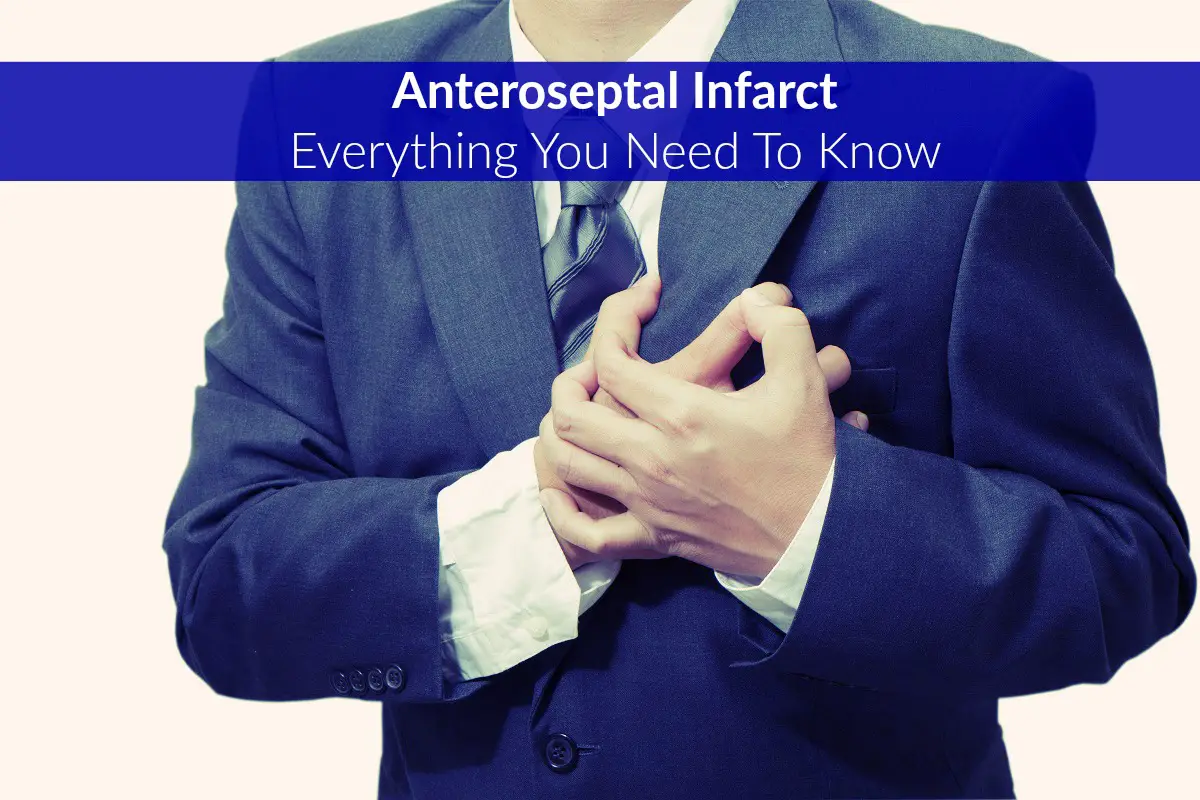Anteroseptal infarct is a serious, and potentially fatal condition affecting the heart.
It must be treated by a highly trained emergency physician to prevent permanent cardiac damage or loss of life.
Anteroseptal infarctions affect the septum, or the wall that divides the left and right side of the heart. The effects of the condition cause a significant decrease in blood flow to a portion of the heart, resulting in tissue death.
There are three main arteries that supply blood flow to the heart.
The artery that provides blood to the septal area of the heart is the left anterior descending artery. When this artery is blocked, the cardiac septum can suffer serious damage which renders it incapable of pumping blood efficiently.
If the anteroseptal infarct becomes severe enough, it can cause significant blood restriction to vital organs in the body. Any long-term deprivation of blood flow to organs can cause permanent damage to their normal function as well, leading to potential organ failure.
It is extremely important that a patient suffering from chest pains or other symptoms of a heart attack, receive treatment as soon as possible.
Treatment can prevent further tissue death and further damage to the heart.
This condition is different than an acute myocardial infarction, or heart attack.
A heart attack is considered a more extensive deprivation of blood to the heart, and can be caused by a full artery blockage.
Multiple studies have proven that untreated anteroseptal infarcts can lead to the development of a myocardial infarction because the damaged tissue is capable of causing an irregular heart rhythm, blood pooling, and coagulation inside of ventricles.
What is an Anteroseptal Infarct?
An anteroseptal infarct is a condition caused by damage to the anterioseptal wall.
This damage is caused by a partial blockage of blood flow in the left anterior descending artery.
The anteroseptum is in the front of the heart and is the wall separating the left side of the heart from the right side of the heart. If this septum is damaged, the heart may be unable to pump enough blood to keep other tissues in the body alive.
If the tissue damage in the heart is significant enough, coma or death can occur rapidly.
Risk Factors
There are many things in your life that make you more likely to suffer from an anteroseptal infarct. Many of them are the same risk factors for having a heart attack.
Risk factors for an anteroseptal infarct are:
» Previous heart attack
» High blood pressure
» History of blood clots
» Clogged arteries
» High cholesterol
» Previous anteroseptal infarct
» Smoking
» Drinking alcohol
» Lack of exercise
» Stress
» Pre-existing autoimmune condition
» Using illegal drugs
» Being overweight
» Family history of heart attack
» Diabetes
» Age – men over the age of 45 are at the greatest risk
Prevention
 If you have been diagnosed with high blood pressure, constricted arteries, or you have previously had a heart attack, your doctor will prescribe a blood thinner. This blood thinner will make it easier for blood to flow through your body.
If you have been diagnosed with high blood pressure, constricted arteries, or you have previously had a heart attack, your doctor will prescribe a blood thinner. This blood thinner will make it easier for blood to flow through your body.
Exercise and blood pressure medication will help strengthen the arteries leading into and out of your heart. Controlling your blood pressure is an important part of preventing anteroseptal infarcts and myocardial infarcts.
If your blood pressure is not under control, your doctor may recommend stents. Stents can be placed in the heart and in arteries to hold them open and allow the proper amount of blood flow.
Other options for preventing infarctions is cardio ablation surgery. This surgery helps deactivate any nerve or portion of the conduction system that is malfunctioning due to poor signal.
By deactivating faulty conductors, your heart will be able to beat regularly and medication is likely to more effective.
Symptoms
Just like with any other heart condition, the symptoms of an anteroseptal infarct may be different from person to person.
The symptoms may be mild to severe. The pain may be excruciating, or barely felt, depending on the pain tolerance of the person experiencing it.
The symptoms of an anteroseptal infarction include:
» Pain in the chest
» Discomfort in the chest
» Feeling of fullness in the chest
» Pressure in the chest
These symptoms may start out minor at first and increase in severity as time goes on. As the symptoms progress, numbness in the extremities may present.
If you are unsure about whether your symptoms fit the anteroseptal infarction criteria, seek emergency care right away. Even if you do not exhibit all of the symptoms, or if your symptoms are vague, you could still be experiencing this condition, or a similar cardiac incident.
Causes
When plaque builds up in an artery, it simply lays against the artery wall. It is not permanently anchored to the tissue. When this plaque breaks loose, it can clog arteries throughout the body.
If this blockage restricts blood flow, it can cause excruciating pain. If the blood blocks blood going directly to the heart, or blocks it in the heart, it can cause cardiac tissue damage.
This damage prevents the heart from pumping blood through the body, causing tissue death, or brain death.
There are many causes for an anteroseptal infarction, including being in one of the “at risk” categories outlined above.
Examination
When a doctor examines a patient complaining of chest pain, they check for myocardial infarction and anteroseptal infarction. The physician will evaluate the symptoms and use an electrocardiograph machine to check the electrical activity of the heart.
The results of this test will allow the doctor to see if anything is abnormal and will provide information about where the damage is located.
The physician uses the information obtained by the electrocardiogram and their own knowledge of the heart’s conduction system to locate any defects, or existing damage to the heart. The two electrical activities the heart uses are called depolarization and repolarization. These electrical signals are used to trigger contraction and relaxation of the heart muscles.
The doctor can use this test to locate new damage, and old damage that a patient has not received treatment for.
Unfortunately, the majority of anteroseptal infarcts are classified under the diagnosis of “heart attack” until further exploration is complete.
Usually, the damage is found during heart catheterization or during exploratory surgery. Fortunately, many of the same medications that are given during a heart attack are prescribed for anteroseptal infarctions.
Treatment
 It is important for treatment to be sought immediately to ensure that as much at risk tissue is saved as possible. Failing to receive timely treatment may lead to permanent damage.
It is important for treatment to be sought immediately to ensure that as much at risk tissue is saved as possible. Failing to receive timely treatment may lead to permanent damage.
Treatment for an anteroseptal infarct involves medications that stimulate the heart. Other medications are used to break up the blockage inside the artery that is causing the problem. If no positive result is obtained by the medications, surgery may be required to prevent further damage to the heart.
Typically, the surgery elected is a bypass, which is used when a portion of an artery is completely blocked.
If multiple arteries have been blocked, stents may be placed inside of arteries to ensure that blood can flow freely through all arteries.
After treatment has been given, hospitalization is almost always required. Instructions will be given to adjust diet, change lifestyle, and increase physical activity.
Blood pressure medication may be necessary to prevent damage to arteries. Many patients receive the recommendation to take aspirin to thin their blood, which helps it flow easier through constricted arteries.
Complications
There are many complications one can suffer after having an anteroseptal infarction. However, there are four complications that occur more often than others.
These complications are:
» Arrhythmia – An arrhythmia is an electrical short that results in abnormal heart rhythm. An abnormal heart rhythm can seriously impair your life, or even be fatal.
» Heart failure – An attack is capable of severely damaging the heart’s tissue. It can impair the muscle to the point where it is unable to adequately pump blood into, or out of, you heart. Heart failure can be a temporary condition, or it could be permanent.
» Heart rupture – places in the heart that have been weakened from previous damage can break open, or rupture, which leaves a hole in a portion of the heart. This type of rupture is fatal in the majority of cases.
» Valve problems – Because the heart valves are made of muscle, they can be damaged by any form of attack on the heart muscle. If a valve is damaged, it can cause severe leaks of blood in the heart and dramatically lower blood pressure.
Do Not Diagnose Yourself
Any symptom of heart problems can be troubling. It is important for you to seek medical treatment immediately. Do not try to diagnose your own health problems, as it can be difficult.
It is possible for an anteroseptal infarct to mimic a right ventricular infarct, just like other health problems show similar symptoms. It takes a highly trained medical eye to decipher the subtle differences.
Conclusion
If you have any symptoms of an anteroseptal infarct, it is extremely important to receive medical treatment.
If you experience any symptom of a heart related illness, or a disruption in blood flow, you should seek medical treatment right away.
Even the slightest symptom could be the beginning of a larger problem brewing under the surface.
References
“http://emedicine.medscape.com/article/155919-overview
“https://www.healthtap.com/topics/anteroseptal-infarct-symptoms
“http://www.merriam-webster.com/medical/anteroseptal
“http://www.merriam-webster.com/medical/anteroseptal
“http://lifeinthefastlane.com/ecg-library/anterior-stemi/
“http://www.sciencedirect.com/science/article/pii/016752739190364U
“https://www.reference.com/health/anteroseptal-myocardial-damage-4286d0693932ebc3
“https://www.reference.com/health/possible-anteroseptal-infarct-ecg-6d9d5067a1442070#
“http://www.tandfonline.com/doi/abs/10.1081/JCMR-120038647
“http://lifeinthefastlane.com/ecg-library/anterior-stemi/
“https://www.researchgate.net/publication/8366498_Anteroseptal_or_Apical_Myocardial_Infarction_A_Controversy_Addressed_Using_ Delayed_Enhancement_Cardiovascular_Magnetic_Resonance_Imaging
Leave Feedback: Was this article helpful?

